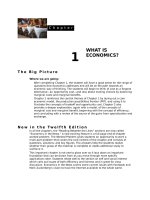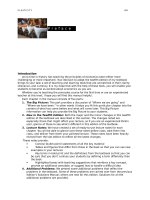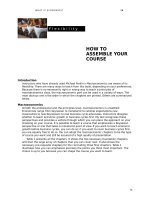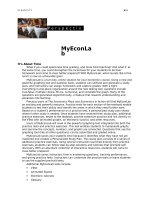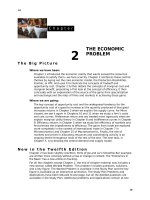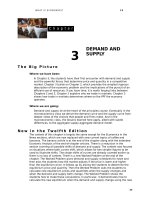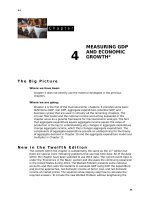Answers to review quizzes marcroeconomics 12e parkin chapter 13
Bạn đang xem bản rút gọn của tài liệu. Xem và tải ngay bản đầy đủ của tài liệu tại đây (488.38 KB, 20 trang )
W H AT I S E C O N O M I C S ?
207
1
3
FISCAL POLICY**
Answers to the Review Quizzes
Page 366 (page 774 in Economics)
1.
What is fiscal policy, who makes it, and what is it designed to influence?
Fiscal policy is the use of the federal budget to achieve macroeconomic objectives.
Fiscal policy is made by the president and Congress. It is designed to influence
employment, economic growth, and price level stability.
2.
What special role does the president play in creating fiscal policy?
Each year the president proposes the budget that Congress amends and enacts.
3.
What special roles do the Budget Committees of the House of
Representatives and the Senate play in creating fiscal policy?
Each year the Budget Committees of the House of Representatives and the Senate
consider the budget proposed by the president, and develop their own ideas of how
it should be modified. Eventually, formal conferences between the two houses
resolve the differences between them and a series of spending acts and an overall
budget act passed.
4.
What is the timeline for the U.S. federal budget each year? When does a fiscal
year begin and end?
Consider the budget for 2015 as an example in answering this question. In
February 2014 the president proposes a budget to Congress. Then, from February
until October 1, 2014, the Congress debates the budget, amends it, and eventually
passes the necessary budget bills. The president then signs or vetoes the budget
bills that were presented to him. When the president vetoes bills, the Congress
may over-ride the veto or pass other bills acceptable to the president. Fiscal year
2015 begins on October 1, 2014 and runs until September 30, 2015. During this
year the Congress may pass—and the president may sign—supplementary bills.
Then, after the fiscal year ends, accounts are prepared and the “official” amounts
of outlays, receipts, and budget deficit or surplus are reported.
5.
Is the federal government budget today in surplus or deficit?
Currently, the U.S. federal government is running a (large) budget deficit.
207
208
Page 371 (page 779 in Economics)
1.
How does a tax on labor income influence the equilibrium quantity of
employment?
A tax on labor income drives a wedge between the after-tax wage rate of workers
and the before-tax wage rate paid by firms. The tax on labor income decreases the
supply of labor. That is, for each before-tax wage rate, workers provide a lower
quantity of labor when faced with a tax that lowers their after-tax wage. The
decrease in labor supply raises the before-tax wage rate, even though the after-tax
wage rate received by workers falls. The decrease in labor supply also means that
the quantity of employment at full employment (i.e., equilibrium employment in
the labor market) falls.
208
2.
How does the tax wedge influence potential GDP?
By decreasing employment, the tax wedge lowers potential GDP.
3.
Why are consumption taxes relevant for measuring the tax wedge?
A tax on consumption raises the price paid for consumption goods and services
and so is equivalent to a cut in the real wage rate from the perspective of workers.
4.
Why are income taxes on capital income more powerful than those on labor
income?
Given positive inflation, what appears to be a moderate tax on interest income
dramatically decreases the real after-tax interest rate, which is the interest rate
that influences investment and saving plans. In particular, by driving a wedge
between the real interest rate savers receive and firms pay, the tax on interest
income decreases the supply of loanable funds, which lowers investment and
saving in the economy.
5.
What is the Laffer curve and why is it unlikely that the United States is on the
“wrong” side of it?
The Laffer curve is the relationship between the tax rate and the amount of tax
revenue collected. The amount of tax revenue collected increases with the tax rate
only up to a certain tax rate, after which, further increases in the tax rate cause
tax revenue to fall. When tax rates are higher than the tax rate that maximizes tax
revenue, a country is said to be on the wrong side of the Laffer curve. It is unlikely
that the United States is on the wrong side of the Laffer curve because U.S. tax
rates are among the lowest in the industrial world and past changes in U.S. tax
rates have produced changes in tax revenues in the same direction.
Page 374 (page 782 in Economics)
1.
What is a present value?
A present value is the amount of money that, if invested today, will grow to equal a
given future amount when the interest that it earns is taken into account.
2.
Distinguish between fiscal imbalance and generational imbalance.
Fiscal imbalance is the present value of the government’s commitments to pay
benefits minus the present value of its tax revenues. Generational imbalance is the
division of the fiscal imbalance between the current and future generations,
assuming that the current generation continues to enjoy the current levels of taxes
and benefits.
3.
How large was the estimated U.S. fiscal imbalance in 2014 and how did it
divide between current and future generations?
In 2014, the fiscal imbalance was estimated to be $68 trillion. The generational
imbalance estimates suggest that the current generation will pay 83 percent and
future generations will pay 17 percent of the fiscal imbalance.
4.
What is the source of the U.S. fiscal imbalance and what are the painful
choices that we face?
The source of the fiscal imbalance is the social security and, especially, the
Medicare obligations made under current law. The painful choices are to raise
income taxes, raise social security taxes, cut social security benefits, or cut federal
government discretionary spending.
5.
How much of U.S. government debt is held by the rest of the world?
U.S. government debt held by the rest of the world is about $5.8 trillion.
Page 379 (page 787 in Economics)
1.
What is the distinction between automatic and discretionary fiscal policy?
FISCAL POLICY
Automatic fiscal policy is triggered by the state of the economy with no need for
any government action. Discretionary fiscal policy, however, requires an act of
Congress to either change government spending and/or change taxes.
2.
How do taxes and needs-tested spending programs work as automatic fiscal
policy to dampen the business cycle?
Taxes, such as income taxes, and needs-tested spending programs both work as
automatic fiscal policy because they decrease the effect a change in income has
on aggregate expenditure. For instance, when income decreases, consumption
expenditure and aggregate expenditure decrease. But with the fall in income,
income taxes decrease and needs-tested spending increase so that disposable
income does not fall as much as does income. The smaller fall in disposable
income means that the fall in consumption expenditure is smaller, so that the fall
in aggregate expenditure is likewise smaller.
3.
How do we tell whether a budget deficit needs discretionary action to remove
it?
A budget deficit needs discretionary government action to remove it when the
deficit is a structural deficit. If the deficit is a structural deficit, then even when the
economy is at full employment, the deficit will remain. However, if the deficit is a
cyclical deficit, then when the economy returns to full employment, the deficit will
disappear.
4.
How can the federal government use discretionary fiscal policy to stimulate
the economy?
If the economy has a recessionary gap, the government can increase its
expenditure or lower taxes to increase aggregate demand and move the economy
back toward potential GDP.
5.
Why might fiscal stimulus crowd out investment?
Fiscal stimulus, such as an increase in government expenditure or a decrease in
taxes, increases the budget deficit. The increase in the budget deficit increases the
(government’s) demand for loanable funds, thereby raising the real interest. The
higher real interest rate decreases—crowds out—investment.
169
170
CHAPTER 13
Answers to the Study Plan Problems and
Applications
Use the following news clip to work Problems 1 and 2.
Economy Needs Treatment
It’s the debt, stupid! Only when the government sets out a credible business plan
will confidence and hiring rebound.
Source: The Wall Street Journal, October 7, 2010
1.
How has the U.S. government debt changed since 2008? What are the
sources of the change in U.S. government debt?
Since 2008 the U.S. government debt has skyrocketed. The debt dramatically rose
because federal government taxes fell (as a percent of GDP) while federal
government expenditures and transfer payments, shot upwards. Federal
government expenditures on goods and services rose but not nearly as much as
transfer payments.
2.
What would be a “credible business plan” for the government to adopt?
A “credible business plan” would be a plan for the government that shrinks the
deficit and thereby stops the rapid increase in the government debt. This plan
likely would involve cutting government outlays and increasing government
receipts.
3.
The government is considering raising the tax rate on labor income. Explain
the supply-side effects of such an action and use appropriate graphs to show
the directions of change, not exact magnitudes. What will happen to:
a. The supply of labor and why?
The supply of labor will decrease. As
shown in Figure 13.1, the supply of labor
curve shifts leftward from LS0 to LS1. The
supply of labor decreases because at
each real wage rate, the hike in the tax
rate on labor income lowers the after-tax
wage rate received by workers.
b. The demand for labor and why?
The demand for labor will remain the
same so in Figure 13.1 the demand for
labor curve remains LD. The demand for
labor depends on the productivity of
labor, which does not change after the
increase in the tax rate on labor income.
c. Equilibrium employment and why?
As Figure 13.1 shows, the equilibrium
level of employment decreases. In the
figure, employment decreases from 310 billion hours per year to 300 billion hours
per year.
d. The equilibrium before-tax wage rate and why?
As Figure 13.1 shows, the equilibrium before-tax wage rate increases from $34 per
hour to $35 per hour. The before-tax wage rate rises because the leftward shift of
the supply of labor curve leads to a movement up along the demand for labor
curve.
FISCAL POLICY
e. The equilibrium after-tax wage rate and why?
The equilibrium after-tax wage rate decreases. The tax wedge in the figure is $2
per hour, so the after-tax wage rate falls from $34 per hour to $33 per hour. The
increase in the tax rate on labor income increases the wedge between the beforetax wage rate and the after-tax wage rate. The before-tax wage rate increases but
not by as much as the increase in tax. So the after-tax wage rate decreases.
171
172
f.
CHAPTER 13
Potential GDP?
Potential GDP decreases. The equilibrium
level of employment is full employment.
So as full employment decreases,
potential GDP decreases along the
aggregate production function. Figure
13.2 shows this change as the
movement along the aggregate
production function, PF, from point A,
with 310 billion hours of employment
and potential GDP of $16.2 trillion, to
point B, with 300 billion hours of
employment and potential GDP $16.1
trillion.
4.
What fiscal policy action might increase investment and speed economic
growth? Explain how the policy action would work.
A decrease in the tax on capital income will increase investment and thereby
increase economic growth. A decrease in the tax on capital income increases the
supply of loanable funds. The real interest rate falls and investment increases. The
increase in investment increases economic growth.
5.
Suppose that instead of taxing nominal capital income, the government taxed
real capital income. Use appropriate graphs to explain and illustrate the effect
that this change would have on:
a. The tax rate on capital income.
The nominal interest rate is the (nominal) income from capital. If the government
changes the tax code to subtract the inflation rate from the (nominal) interest rate
before taxes are imposed, the true tax
rate on capital income falls because the
part of the capital income—the inflation
rate—that is received in compensation
for inflation is no longer taxed.
b. The supply of and demand for
loanable funds.
With a lower tax rate on capital income,
the supply of loanable funds increases
as the after-tax real interest rate rises.
This change is illustrated in Figure 13.3
by the rightward shift of the supply of
loanable funds curve from the initial
supply of loanable funds curve, SLF0, to
SLF1.
The demand for loanable funds
generally remains the same because it
FISCAL POLICY
depends in large part on investment demand. Firms’ investment demand depends
on how productive capital is and the productivity of capital does not necessarily
change when the tax code changes. In Figure 13.3, the demand for loanable funds
curve does not shift.
c. Investment and the real interest rate.
As shown in Figure 13.3, the increase in the supply of loanable funds shifts the
supply of loanable funds curve rightward. This change leads to a lower real
interest rate and a higher amount of loanable funds and investment.
6.
Under current policies, a plausible projection is that U.S. public debt will reach
250 percent of GDP in 30 years and 500 percent in 50 years.
a. What is a fiscal imbalance? How might the U.S. government reduce the fiscal
imbalance?
The fiscal imbalance is the present value of the government’s commitments to pay
benefits minus the present value of its tax revenues. To reduce the fiscal
imbalance, the government needs to decrease its benefit payments—both its
present payments and those promised in the future—and increase its tax revenue
—both its current tax revenue and tax revenue in the future. While the annual
government budget deficit is not the fiscal imbalance, it is related because, in
general, the larger the budget deficit the larger the fiscal imbalance. Additionally,
the larger the budget deficit, the larger the accumulated public debt becomes.
b. How would your answer to part (a) influence the generational imbalance?
The generational imbalance is the division of the fiscal imbalance between the
current and future generations, assuming that the current generation will enjoy the
existing levels of taxes and benefits. The changes in part (a) of cutting benefits
and raising taxes will affect the generational imbalance if the reduction in benefits
and/or the hike in taxes affects the current generation. In that case the
generational imbalance would change so that more of the fiscal imbalance is paid
by the current generation and less by future generations.
7.
The economy is in a recession, and the recessionary gap is large.
a. Describe the discretionary and automatic fiscal policy actions that might
occur.
Fiscal policy that increases government expenditure or decreases taxes would
boost aggregate demand. In terms of automatic fiscal policy, needs-tested
spending increases in recessions and tax revenue falls. Congress might also use
discretionary policy by passing a new spending bill or a cut in tax rates.
b. Describe a discretionary fiscal stimulation package that could be used that
would not bring an increase in the budget deficit.
An increase in government expenditure with an offsetting increase in tax rates to
boost tax revenue would not bring a budget deficit and would increase aggregate
demand because the increase in government expenditure increases aggregate
demand by more than the increase in taxes decreases aggregate demand.
c. Explain the risks of discretionary fiscal policy in this situation.
The risk of discretionary policy is that, because of time lags, it takes effect too late
and ends up moving the economy away from potential GDP.
8.
An economy is in a recession with a large recessionary gap and a government
budget deficit.
a. Do we know whether the budget deficit is a structural deficit or a cyclical
deficit? Explain.
We know that at least some of the budget deficit in a recession is a cyclical deficit
as needs-tested spending is higher and tax revenue is lower than at potential GDP.
173
174
CHAPTER 13
However, some of the budget deficit might be a structural deficit. The structural
deficit is the deficit that would exist if real GDP equaled potential GDP and the
economy was at full employment.
b. Explain how automatic fiscal policy is changing the output gap?
Automatic fiscal policy is decreasing the output gap relative to what it would be
otherwise in a recession because they increase aggregate demand relative to what
it would be otherwise in a recession. That is, aggregate demand decreases in a
recession, but it would decrease by more without the increase in needs-tested
spending and the decrease in tax revenue that produce the cyclical deficit.
c. If the government increases its discretionary expenditure, explain how the
structural deficit might change.
A discretionary increase in government expenditure, if not reversed following the
end of the recession, moves the budget balance toward a structural deficit.
Use the following news clip and fact to work Problems 9 to 11.
Senate Approves Obama Tax Cut Plan
The U.S. Senate has passed legislation extending Bush-era tax cuts for highincome earners to middle-class Americans earning up to $250,000 per year.
Source: Financial Times, July 26, 2012
Fact: Middle and low-income earners spend almost all their disposable incomes.
High-income earners save a significant part of their disposable incomes.
9. a. Explain the intended effect of
extending tax cuts for middle-class
Americans but not for high-income
families. Draw a graph to illustrate
the intended effect.
The goal of extending the tax cuts for
middle-class Americans has an
intended effect of increasing
consumption expenditure, which
increases aggregate demand. Figure
13.4 shows the intended effect of this
policy where, including the multiplier
effect, the aggregate demand curve
shifts rightward from AD0 to AD1. As a
result real GDP increases, in the figure
from $15.7 trillion to $15.9 trillion. In
the figure real GDP remains below
potential GDP but the recessionary gap
becomes smaller.
b. Explain why the effect of tax cuts depends on who receives them.
The effect of this fiscal policy depends on the size of the impact on aggregate
demand. The more of the tax cut that is spent (which means the less that is saved)
the larger the magnitude of the effect on aggregate demand. If the tax rebates go
to people who spend more of the rebate, that is, middle and low-income earners,
the effect of this fiscal policy is larger.
10.
What would have a larger effect on aggregate demand: extending the Bushera tax cuts to everyone; extending them for middle-class only; or extending
them for high-income earners only? How would each alternative compare with
no tax cuts but an equivalent increase in government expenditure?
Extending the income tax cuts to everyone will have the largest effect on
FISCAL POLICY
aggregate demand. Middle-income tax payers will spend most of the tax cut and
high-income tax payers, while spending only a small fraction of their income, still
spend some. In general, tax cuts have a larger effect on real GDP than do
increases in government expenditure because the tax cuts have stronger supplyside effects. So whichever tax cut policy—extending the tax cuts to everyone, to
only middle-class taxpayers, or to only high-income tax payers—has the largest
supply-side effect also has the largest effect on real GDP.
11.
Compare the impact on equilibrium real GDP of a same-sized decrease in
taxes and increase in government expenditure on goods and services.
According to the aggregate demand/aggregate supply model, the government
expenditure multiplier exceeds the tax multiplier, so government expenditure has
a larger impact on real GDP. Some economists, such as Robert Barro and Harald
Uhlig disagree and assert that the tax multiplier exceeds the government
expenditure multiplier because taxes affect aggregate demand and aggregate
supply. In this case the decrease in taxes has a larger impact on real GDP.
175
176
CHAPTER 13
Answers to Additional Problems and Applications
12.
2012 Deficit: Smaller, But Still Big
The Congressional Budget Office said the budget deficit was about $1.1
trillion in fiscal year 2012. That is about $200 billion smaller than in 2011, but
still ranks as the fourth-largest deficit since World War II.
Source: The Congressional Budget Office, October 5, 2012
Of the components of government outlays and receipts, which have changed
most to contribute to the huge budget deficits in 2011 and 2012?
In general, since 2008 outlays have increased substantially while receipts have
risen slightly. The major factor leading to the massive rise in the budget deficit is
an increase in transfer payments. An increase in government expenditure on
goods and services also has lead to increasing the budget deficit but the effect
from this factor is dwarfed by the rise in transfer payments.
Use the following information to work Problems 13 and 14.
Suppose that investment is $1,600 billion, saving is $1,400 billion, government
expenditure on goods and services is $1,500 billion, exports are $2,000 billion, and
imports are $2,500 billion.
13.
Calculate the amount of tax revenue and the government budget balance.
Tax revenue equals $1,200 billion. From the circular flow of expenditure and
income, we know that
I = S + T – G + M – X. Rearranging the equation gives T = I– S + G + X – M, which
equals $1,200 billion.
14.a. Explain the impact of the government budget balance on investment.
The government has a budget deficit. It is exerting a negative influence on
investment by increasing the demand for loanable funds, which increases the real
interest rate and crowds out investment.
b. What fiscal policy action might increase investment and speed economic
growth? Explain how the policy action would work.
A decrease in the budget deficit by increasing taxes or decreasing government
expenditure decreases the demand for loanable funds, which lowers the real
interest rate and increases investment. The increase in investment increases
economic growth.
15.
Suppose that capital income taxes are based (as they are in the United
States) on nominal interest rates. If the inflation rate increases by 5 percent a
year, explain and use appropriate graphs to illustrate the effect of the rise in
inflation on:
a. The tax rate on capital income.
The increase in the inflation rate increases the true tax rate on capital income
because the interest income that is received in compensation for inflation is larger
so that the tax paid on capital income increases.
FISCAL POLICY
b. The supply of loanable funds.
With a higher tax rate on capital
income, the supply of loanable funds
decreases and the after-tax real interest
rate falls. This change is illustrated in
Figure 13.5 by the leftward shift of the
supply of loanable funds curve from the
initial supply of loanable funds curve
SLF0 to the new supply, SLF1, when the
inflation rate is higher.
c. The demand for loanable funds.
The demand for loanable funds
generally remains the same because it
depends in large part on investment
demand. Firms’ investment demand
depends on how productive capital is
and the productivity of capital does not
change when the tax code changes.
d. Equilibrium investment.
As illustrated in Figure 13.5, when the
supply of loanable funds decreases, the supply of loanable funds curve shifts
leftward from SLF0 to SLF1. The real interest rate rises from 4 percent a year to 5
percent a year, and the equilibrium quantity of loanable funds deceases from $2.5
trillion to $2.4 trillion. Investment decreases.
e. The equilibrium real interest rate.
The decrease in the supply of loanable funds leads to a higher equilibrium real
interest rate. In the figure the real interest rate rises from 4 percent to 5 percent.
Use the following news clip to work Problems 16 and 17.
Singapore Budget 2015: Parliament Passes Record $79.9 Billion Budget
New schemes announced by the budget statement include ten new hawker
centers by 2027, a third desalination plant, SkillsFuture initiative to support lifelong
learning for adults, and a second edition of Construction Productivity Roadmap to
boost the industry’s capabilities.
Source: The Straits Times, March 13, 2015
16.
Explain the supply-side effects of building ten new hawker centers and a third
desalination plant.
The construction of ten new hawker centers and a third desalination plant creates
more job opportunities, thereby boosting employment.
17.a. Explain the potential supply-side and demand-side effects of SkillsFuture
initiative.
The SkillsFuture initiative will give adult Singaporeans the opportunity to develop
new skills and respond to the constantly evolving needs of industry. This will help
many employees to keep their jobs or make progress in their career. The initiative,
thus, may not necessarily create more employment. Therefore, aggregate supply
may or may not increase. However, as employees’ real wages increase due to
better skills and better employment opportunities, consumption expenditure rises,
so aggregate demand increases from what it would be otherwise.
177
178
CHAPTER 13
b. Explain the potential supply-side and demand-side effects of adopting new
technologies to boost productivity in the construction industry.
Use of new technologies increases both short-run and long-run aggregate supply.
More capital investment by construction companies will increase aggregate
demand as well.
FISCAL POLICY
c. Draw a graph to illustrate the combined demand-side and supply-side effect
of the fiscal
policy measures in
part (a).
Figure 13.6 shows the combined effects
of the policy compared to what the
situation would be if the policies not
implemented. Aggregate demand
increases, so the aggregate demand
curve shifts rightward from AD0 to AD1.
The effect on aggregate supply is
ambiguous. Implementing the initiative
may or may not increase aggregate
supply. If aggregate supply does not
change, the aggregate supply curve
does not shift. In Figure 13.6 the shift of
the aggregate demand curve increases
real GDP, and the price level rises.
Use the following news clip to work
Problems 18 and 19.
China pulls back tax breaks for foreign companies
Incentives such as lower land prices and tax breaks have helped Chinese cities
attract multinational firms in the recent years. In 2014 alone, it secured foreign
investment worth $120 billion. Now, the central government is ordering
municipalities to pull back the incentives to curb the country’s growing debt and
local spending.
Source: CNN Money, March 27, 2015
18.
Explain the potential supply-side effects of China’s plan to pull back tax
breaks?
When there are no more tax breaks, foreign firms in China will expect decreased
profits. Investment in the country’s capital stock decreases. Aggregate supply and
potential GDP both decrease.
19.
How does withdrawing tax breaks that were granted to foreign firms curb the
country’s debt? Explain your answer with the aid of the Laffer curve.
After tax breaks are pulled back, foreign firms will have to pay more tax. The tax
rate imposed on foreign firms lies on the upward-sloping portion of the Laffer
curve, which indicates that an increase in the tax rate increases the tax revenue.
The budget deficit decreases, exerting less pressure on the accumulating debt of
the country.
179
180
CHAPTER 13
20.
Hong Kong Launches Rainy-day Fund Despite of HK$950b Reserves by
2020
By 2019–20, the fiscal reserves are predicted to reach HK$950 billion, enough to
cover 22 months of the government’s projected expenditure. However, Finance
Secretary John Tsang’s working group on long-term fiscal planning has warned that
HK could face a structural deficit by 2022–23 due to an ageing population. The
group proposes to set up a “future fund” for a rainy day, to be used if HK’s
reserves drops to a critical level.
Source: South China Morning Post, Feb 26, 2015
What is the difference between structural deficit and cyclical deficit? Explain how
an ageing population may lead to a structural deficit. If the source of the future
fund is the existing fiscal reserves, who would benefit from the establishment of
the fund and who would pay?
A structural deficit is the budget deficit at the potential GDP, while a cyclical deficit
is the actual deficit minus structural deficit. As more people retire, the workforce
shrinks, fewer people pay taxes and the income tax revenue decreases. On the
other hand, the social expenditure on the elderly grows. The fiscal deficit
eventually turns into a structural deficit while the ageing population continues to
age.
For the future fund, if the government broadens the tax base, the current
generation would pay but the future generation would benefit because they do not
have to pay higher taxes to cover the fiscal deficit.
21.
The economy is in a boom and the inflationary gap is large.
a. Describe the discretionary and automatic fiscal policy actions that might
occur.
Fiscal policy that decreases expenditure or increases taxes would decrease
aggregate demand. In terms of automatic fiscal policy, need-tested spending
decreases in expansions and tax revenue increases. Congress might also use
discretionary policy by cutting spending programs or increasing tax rates.
b. Describe a discretionary fiscal restraint package that could be used that
would not produce serious negative supply-side effects.
A decrease in government expenditure with an offsetting decrease in autonomous
taxes would not bring a change in government saving and so would not change
investment and the growth of real GDP.
c. Explain the risks of discretionary fiscal policy in this situation.
The risk of discretionary policy is that, because of time lags, it takes effect too late
and ends up moving the economy away from potential GDP.
22.
The economy is growing slowly, the inflationary gap is large, and there is a
budget deficit.
a. Do we know whether the budget deficit is structural or cyclical? Explain your
answer.
The economy is at an above full-employment equilibrium because there is an
inflationary gap. Real GDP exceeds potential GDP. There is a budget deficit, but
with potential GDP greater than real GDP there is a cyclical surplus. The structural
deficit is larger than the total budget deficit because the cyclical surplus offsets
some of structural deficit. So the budget deficit is composed of a structural deficit
and a cyclical surplus.
FISCAL POLICY
b. Do we know whether automatic stabilizers are increasing or decreasing
aggregate demand? Explain your answer.
We know that automatic stabilizers are decreasing aggregate demand relative to
what it would be otherwise in an inflationary gap.
c. If a discretionary decrease in government expenditure occurs, what happens
to the structural budget balance? Explain your answer.
A discretionary decrease in government expenditure decreases the structural
deficit. Following the change in fiscal policy, government outlays would be smaller
even when the economy returned to full employment.
Use the following news clip to work Problems 23 to 25.
Is Fiscal Stimulus Necessary?
China’s economy is slowing from its normal 9 percent or higher rate to just below 9
percent. The source of the slowdown is the global economic slowdown that is
restricting exports growth and the government’s deliberate decision to discourage
unproductive investment. The situation now is not like that in 2008 when real GDP
growth dropped from 9 percent to 6.8 percent and fiscal stimulus does not appear
to be urgently needed.
Source: China Daily, June 8, 2012
23.
Explain why fiscal stimulus was needed in 2008 but not in 2012.
Fiscal stimulus was needed in 2008 because the growth rate of the Chinese
economy significantly slowed. The slowdown in the growth rate in 2012 is much
milder and hence fiscal stimulus is not needed.
24.
Would you expect automatic stabilizers to be operating in 2012 and if so,
what effects might they have?
China’s automatic stabilizers will operate in 2012. China has fewer automatic
stabilizers than the United States because China has fewer unemployment benefit
programs and fewer welfare programs. China’s income tax, however, will operate
as an automatic stabilizer as fewer people rise into higher tax brackets and some
fall into lower tax brackets.
181
182
25.
CHAPTER 13
Why might a stimulus come too late? What are the potential consequences of
a stimulus coming too late?
Stimulus might come too late because forecasters’ predictions that the slowdown
in China’s growth will be slight might prove incorrect. So stimulus might be
delayed until the economy was actually in a recession. If this outcome occurred,
the unemployment rate would already have risen and real GDP already have
decreased because of the delay in implementing the program. Additionally, if the
program is implemented too late, then GDP might already be rising and
unemployment falling when the program’s impacts occur, which could result in a
significantly higher price level.
Economics in the News
26.
After you have studied Reading Between the Lines on pp. 380–381 (788–789
in Economics), answer the following questions.
a. What was the state of the Japanese economy in 2013?
After a long period of slow economic growth, in 2013 Japan’s economy was in a
recessionary gap. Gross government debt was 250 percent of GDP. The nation’s
population as ageing and its Social Security payments had skyrocketed to about a
third of the government’s total budget.
b. Explain the effects of Japan’s high level of government spending and debt
the level of employment and potential GDP.
The high level of government debt and deficit had crowded out private investment,
thereby decreasing potential GDP. The decrease in potential GDP decreased
employment.
c. Explain how inflation and faster growth might lower Japan’s government
debt ratio and why neither is an attractive option.
Increasing either inflation or faster growth reduces the ratio of debt to nominal
GDP. Faster growth is hard to achieve and increasing inflation would adversely
affect workers with long-term labor contracts (because higher inflation reduces
their real wage rates) and savers (because higher, unanticipated inflation reduces
the real value of the savings).
FISCAL POLICY
d. Explain how monetary policy might be used to offset a fiscal-policy induced
decrease in aggregate demand and draw a graph to illustrate your answer.
Monetary policy can be used to
increase aggregate demand, thereby
offsetting the decrease brought about
by fiscal policy. This offset prevents
real GDP and employment from
decreasing. In Figure 13.7, the initial
aggregate demand curve is AD0 so
that real GDP is ¥540 trillion and the
price level is 122. Fiscal policy
designed to decrease the deficit
decreases aggregate demand to AD1
so that real GDP decreases to ¥520
trillion yen. But the expansionary
monetary policy could increase
aggregate demand, shifting it from
AD1 back to AD0. Real GDP remains at
¥540 trillion. .
27. More Fiscal Stimulus Needed?
In New York Times articles and in blogs, economists Paul Krugman and Joseph
Stiglitz say there is a need for more fiscal stimulus in both the United States and
Europe despite the large federal budget deficit and large deficits in some
European countries.
a. Do you agree with Krugman and Stiglitz? Why?
Students who agree with Mr. Krugman and Mr. Stiglitz likely believe that the U.S.
economy will not return to full employment rapidly without further government
stimulus. Students who disagree with Mr. Krugman and Mr. Stiglitz likely believe
that the U.S. economy is on track to return to full employment.
b. What are the dangers of not engaging in further fiscal stimulus?
If the economy is not returning to full employment, fiscal stimulus might be
necessary. In this situation, if there is no fiscal stimulus, the economy will remain
mired in a recessionary gap and unemployment will exceed natural
unemployment.
c. What are the dangers of embarking on further fiscal stimulus when the
budget is in deficit?
The fiscal stimulus will further increase the budget deficit. The rise in the deficit
increases the government’s demand for loanable funds and thereby raises the real
interest rate. The higher real interest rate decreases—crowds out—investment. The
net effect on aggregate demand is uncertain: The fiscal stimulus increases
aggregate demand; however, the decrease in investment expenditure decreases
aggregate demand. If aggregate demand does not change, there is no immediate
effect on real GDP. But the decrease in investment lowers the future capital stock,
which means that aggregate supply does not increase as much as otherwise so
that U.S. economic growth will be slower.
183
184
CHAPTER 13
28. Payroll Tax Cut Is Unlikely to Survive Into Next Year
The payroll tax holiday in 2012 reduced workers’ tax by $700 for an income of
$35,000 a year and by $2,202 for incomes of $110,100 and over. If the tax holiday
ends, the Economic Policy Institute recommends replacing the payroll tax cut with
infrastructure spending.
Source: The New York Times, September 30, 2012
a. Explain how a payroll tax affects the before-tax and after-tax wage rate and
employment and unemployment.
The payroll tax places a wedge between the before-tax wage rate and the after-tax
wage rate. The payroll tax raises the before-tax wage rate (though by less than the
amount of the tax) and lowers the after-tax wage rate. Employment decreases and
unemployment increases.
b. Explain the effects of an increase in infrastructure spending on employment
and unemployment.
In the short-run, an increase in infrastructure increases aggregate demand, which
increases real GDP and thereby increases employment and decreases
unemployment. In the longer-run, an increase in infrastructure spending increases
the nation’s productive resources, which increases potential GDP and short-run
aggregate supply. The increase in short-run aggregate supply increases
employment and decreases unemployment.
c. Which fiscal policy action would have the bigger effect on employment:
continuing the payroll tax cut or new infrastructure spending?
The payroll tax cut has only an aggregate supply effect; the infrastructure
spending increases both aggregate supply and aggregate demand. Because the
increase in infrastructure spending affects both aggregate demand and aggregate
supply, it might have a larger effect on employment.
FISCAL POLICY
185


